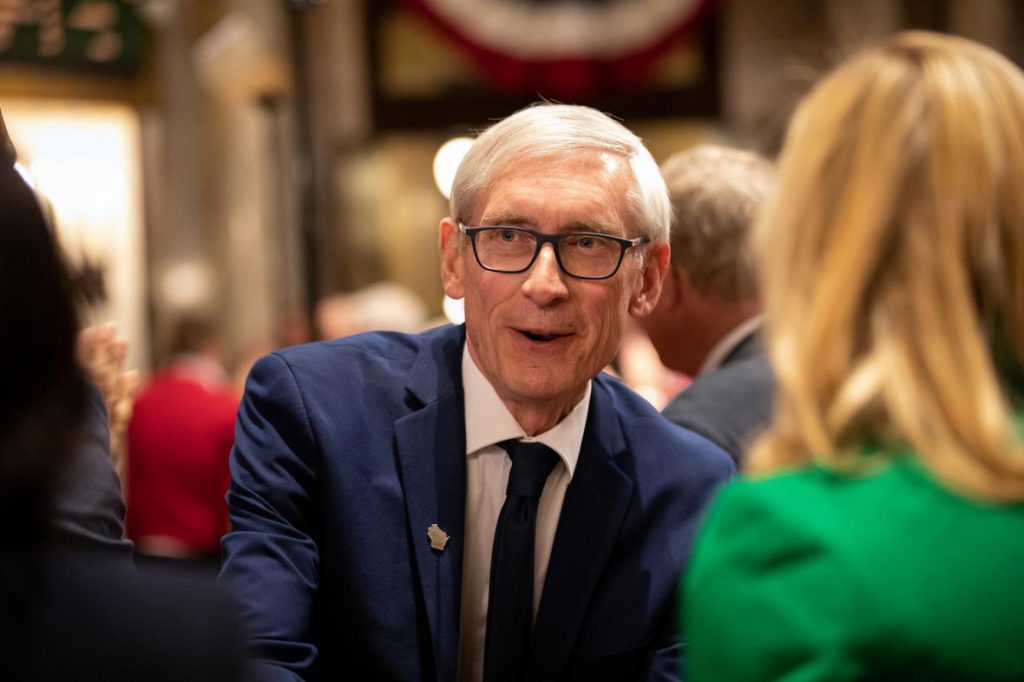How Evers Would End Gerrymandering
He proposes non-partisan redistricting plan similar to Iowa’s.

Gov. Tony Evers greets members of the Assembly and Senate after giving his first State of the State address in Madison, Wisconsin, at the state Capitol building on Jan. 22, 2019. Photo by Emily Hamer/Wisconsin Center for Investigative Journalism.
Democrat Tony Evers is the first governor in Wisconsin history to include a non-partisan plan to draw new boundaries for legislative and Congressional districts in his proposed state budget.
That’s major progress in the fight against gerrymandering – the practice in which the party that controls the Legislature draws districts that make sure it keeps control, say two former state senators who spent years pushing for what Evers proposed.
Before 2011, when Republicans drew lines that made sure they stayed in control of the Legislature for 10 years, “nobody ever noticed” how those lines were drawn, said Democrat and former Senate majority leader Tim Cullen.
Federal judges ended up drawing new districts after U.S. census counts in 1980, 1990 and 2000 – a process that escaped public attention, Cullen added.
Another former Senate majority leader, Republican Dale Schultz, said he and Cullen spent years explaining “reapportionment” – the official term for the process of drawing new districts – across the state.
As a result of educational efforts, and a still-pending lawsuit that challenged Republican-drawn lines that went all the way to the U.S. Supreme Court, Wisconsin residents now understand why the changes recommended by Evers are needed, Cullen and Schultz said.
Voters “should get to choose their elected officials – and not the other way around,” Evers said in his budget message to the Legislature. The process the governor recommended:
*Creation of a five-member “redistricting advisory commission” that would oversee the Legislative Reference Bureau (LRB), which would draft proposed legislative and Congressional district maps.
*Each of the four legislative leaders would name one panel member; the four would pick the fifth. None could be a registered Wisconsin ‘elector,” someone who holds “partisan public office” or anyone who works for or is related to someone who holds public office or works in the Legislature or in Congress.
*By January 2022, the LRB must present a first set of proposed legislative and Congressional district maps, which would be the subject of public hearings and voted on in either the Assembly or Senate within seven days. The maps could not be amended.
*If the first house of the Legislature approves the first maps, they must get an “expeditious” vote in the other house.
*If the first set of maps fails to pass one house, leaders of that house must note reasons “why the plan was not approved.”
*Within three weeks after the vote that killed the first set of maps, the LRB must present a second set, which also must get a vote in one house of the Legislature within seven days. The second set of maps could not be amended.
*If the second set of maps is also rejected, the LRB must deliver a third set within 21 days and that set must get a vote within seven days. The third set of maps could be amended, but only by a “three-fourths [vote] of all the members elected in each house.”
Cullen said the requirement that any amendment to the third maps be passed by 75 percent of legislators means one party could not force passage of maps stacked in its favor.
That’s an improvement from Iowa’s redistricting process, which doesn’t have the 75 percent requirement, Cullen added.
Iowa has had its legislative and Congressional district lines drawn by a non-partisan panel, and then adopted by both the Legislature and governor, since 1980. Iowa’s system is so popular there has not been any attempt to change it, Cullen said.
Cullen said there is only a “slim chance” that Republicans who control Wisconsin’s Legislature will seriously consider the governor’s proposal.
But, Cullen said, even if Republicans kill the non-partisan redistricting proposal, Evers would veto new maps drawn to keep Republicans in control of the Legislature.
“We will not have gerrymandering in 2021,” Cullen said. The changes Evers wants “would fix the problem permanently,” he added.
A contract between Republican legislators and a law firm released by Assembly Speaker Robin Vos says taxpayers could be charged at least $840,000 to defend districts Republicans drew in 2011.
Asked about the governor’s proposal, Vos aide Kit Beyer said: “Like previous budgets, policy items will be removed from the budget proposal – including the governor’s redistricting plan. Speaker Vos favors the current system for redistricting.”
Steven Walters is a senior producer for the nonprofit public affairs channel WisconsinEye. Contact him at stevenscotwalters@gmail.com
More about the Gerrymandering of Legislative Districts
- Without Gerrymander, Democrats Flip 14 Legislative Seats - Jack Kelly, Hallie Claflin and Matthew DeFour - Nov 8th, 2024
- Op Ed: Democrats Optimistic About New Voting Maps - Ruth Conniff - Feb 27th, 2024
- The State of Politics: Parties Seek New Candidates in New Districts - Steven Walters - Feb 26th, 2024
- Rep. Myers Issues Statement Regarding Fair Legislative Maps - State Rep. LaKeshia Myers - Feb 19th, 2024
- Statement on Legislative Maps Being Signed into Law - Wisconsin Assembly Speaker Robin Vos - Feb 19th, 2024
- Pocan Reacts to Newly Signed Wisconsin Legislative Maps - U.S. Rep. Mark Pocan - Feb 19th, 2024
- Evers Signs Legislative Maps Into Law, Ending Court Fight - Rich Kremer - Feb 19th, 2024
- Senator Hesselbein Statement: After More than a Decade of Political Gerrymanders, Fair Maps are Signed into Law in Wisconsin - State Senate Democratic Leader Dianne Hesselbein - Feb 19th, 2024
- Wisconsin Democrats on Enactment of New Legislative Maps - Democratic Party of Wisconsin - Feb 19th, 2024
- Governor Evers Signs New Legislative Maps to Replace Unconstitutional GOP Maps - A Better Wisconsin Together - Feb 19th, 2024
Read more about Gerrymandering of Legislative Districts here
The State of Politics
-
A Wisconsin Political Trivia Quiz
 Dec 15th, 2025 by Steven Walters
Dec 15th, 2025 by Steven Walters
-
The Fight Over Wisconsin’s House Districts
 Dec 8th, 2025 by Steven Walters
Dec 8th, 2025 by Steven Walters
-
The Battle Over On-Line Betting
 Nov 24th, 2025 by Steven Walters
Nov 24th, 2025 by Steven Walters






















Or… Simply state than all districts must have 4 sides unless bounded by a natural feature such as a river. Could also be very progressive and have an algorithm draw the fairest maps possible in a few seconds if fed the right data.